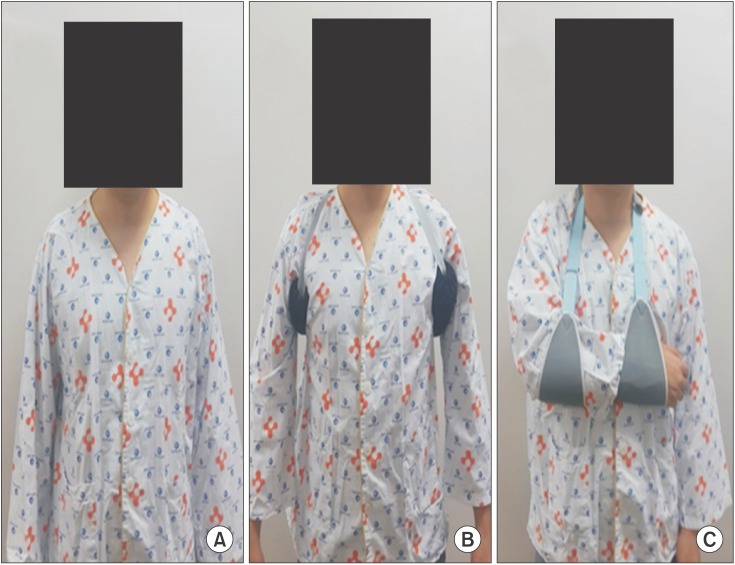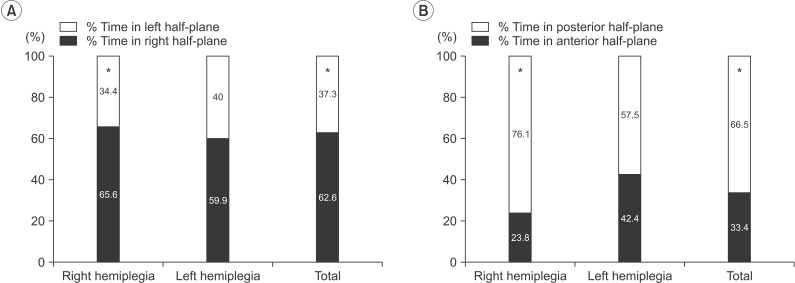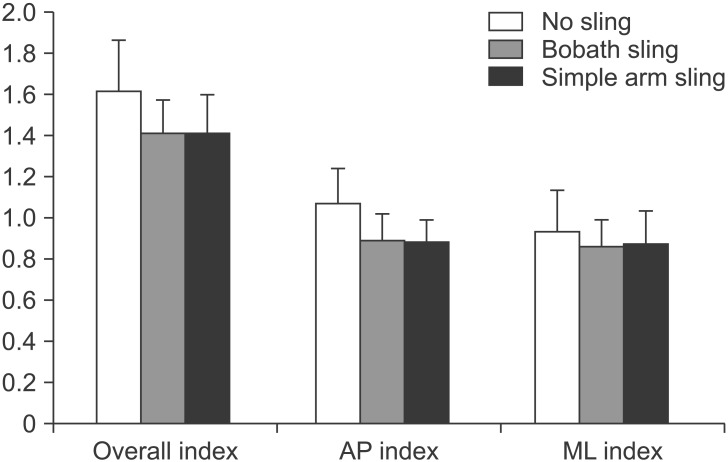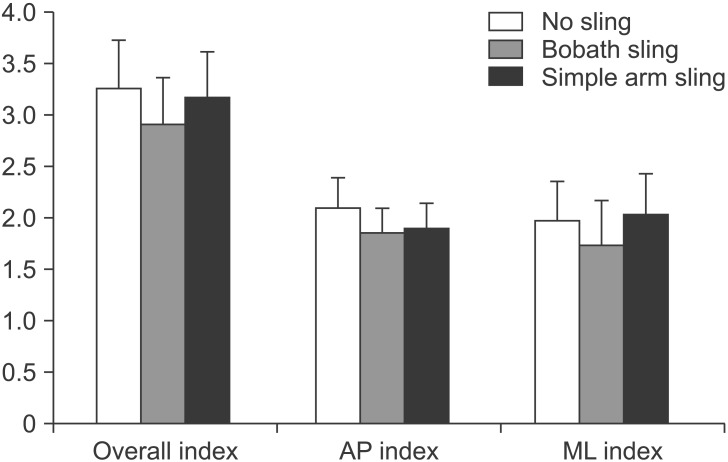Ann Rehabil Med.
2015 Dec;39(6):986-994. 10.5535/arm.2015.39.6.986.
The Effects of Shoulder Slings on Balance in Patients With Hemiplegic Stroke
- Affiliations
-
- 1Department of Rehabilitation Medicine, Chungnam National University Hospital, Daejeon, Korea. sasijin@cnuh.co.kr
- KMID: 2165626
- DOI: http://doi.org/10.5535/arm.2015.39.6.986
Abstract
OBJECTIVE
To investigate the effects of a shoulder sling on balance in patients with hemiplegia.
METHODS
Twenty-seven hemiplegic stroke patients (right 13, left 14) were enrolled in this study. The subjects' movement in their centers of gravity (COGs) during their static and dynamic balance tests was measured with their eyes open in each sling condition-without a sling, with Bobath's axillary support (Bobath sling), and with a simple arm sling. The percent times in quadrant, overall, anterior/posterior, and medial/lateral stability indexes were measured using a posturography platform (Biodex Balance System SD). Functional balance was evaluated using the Berg Balance Scale and the Trunk Impairment Scale. All balance tests were performed with each sling in random order.
RESULTS
The COGs of right hemiplegic stroke patients and all hemiplegic stroke patients shifted to, respectively, the right and posterior quadrants during the static balance test without a sling (p<0.05). This weight asymmetry pattern did not improve with either the Bobath or the simple arm sling. There was no significant improvement in any stability index during either the static or the dynamic balance tests in any sling condition.
CONCLUSION
The right and posterior deviations of the hemiplegic stroke patients' COGs were maintained during the application of the shoulder slings, and there were no significant effects of the shoulder slings on the patients' balance in the standing still position.
Keyword
Figure
Reference
-
1. Gresham GE, Duncan PW, Stason WB, Adams HP, Adelman AM, Alexander DM, et al. Post-stroke rehabilitation: assessment, referral, and patient management: quick reference guide for clinicians. J Geriatr Drug Ther. 1996; 11:7–44.2. Lamb SE, Ferrucci L, Volapto S, Fried LP, Guralnik JM. Women's Health and Aging Study. Risk factors for falling in home-dwelling older women with stroke: the Women's Health and Aging Study. Stroke. 2003; 34:494–501. PMID: 12574566.3. Chen IC, Cheng PT, Hu AL, Liaw MY, Chen LR, Hong WH, et al. Balance evaluation in hemiplegic stroke patients. Chang Gung Med J. 2000; 23:339–347. PMID: 10958036.4. Bonan IV, Colle FM, Guichard JP, Vicaut E, Eisenfisz M, Tran Ba Huy P, et al. Reliance on visual information after stroke. Part I: Balance on dynamic posturography. Arch Phys Med Rehabil. 2004; 85:268–273. PMID: 14966712.
Article5. Paci M, Nannetti L, Rinaldi LA. Glenohumeral subluxation in hemiplegia: an overview. J Rehabil Res Dev. 2005; 42:557–568. PMID: 16320150.
Article6. Turner-Stokes L, Jackson D. Shoulder pain after stroke: a review of the evidence base to inform the development of an integrated care pathway. Clin Rehabil. 2002; 16:276–298. PMID: 12017515.
Article7. Zorowitz RD, Idank D, Ikai T, Hughes MB, Johnston MV. Shoulder subluxation after stroke: a comparison of four supports. Arch Phys Med Rehabil. 1995; 76:763–771. PMID: 7632133.
Article8. Lee DK, Han SJ, Yoon SI, Kim MJ, Lee KH. Effect of arm sling on standing balance of hemiplegic patients. J Korean Acad Rehabil Med. 2004; 28:532–536.9. Acar M, Karatas GK. The effect of arm sling on balance in patients with hemiplegia. Gait Posture. 2010; 32:641–644. PMID: 20888770.
Article10. Rensink M, Schuurmans M, Lindeman E, Hafsteinsdottir T. Task-oriented training in rehabilitation after stroke: systematic review. J Adv Nurs. 2009; 65:737–754. PMID: 19228241.
Article11. Cachupe WJ, Shifflett B, Kahanov L, Wughalter EH. Reliability of biodex balance system measures. Meas Phys Educ Exerc Sci. 2001; 5:97–108.
Article12. Berg K, Wood-Dauphine S, Williams JI, Gayton D. Measuring balance in the elderly: preliminary development of an instrument. Physiother Can. 1989; 41:304–311.
Article13. Verheyden G, Nieuwboer A, Mertin J, Preger R, Kiekens C, De Weerdt W. The Trunk Impairment Scale: a new tool to measure motor impairment of the trunk after stroke. Clin Rehabil. 2004; 18:326–334. PMID: 15137564.
Article14. Blum L, Korner-Bitensky N. Usefulness of the Berg Balance Scale in stroke rehabilitation: a systematic review. Phys Ther. 2008; 88:559–566. PMID: 18292215.
Article15. Stevenson TJ. Detecting change in patients with stroke using the Berg Balance Scale. Aust J Physiother. 2001; 47:29–38. PMID: 11552860.
Article16. Shumway-Cook A, Anson D, Haller S. Postural sway biofeedback: its effect on reestablishing stance stability in hemiplegic patients. Arch Phys Med Rehabil. 1988; 69:395–400. PMID: 3377664.17. Davidson BS, Madigan ML, Nussbaum MA. Effects of lumbar extensor fatigue and fatigue rate on postural sway. Eur J Appl Physiol. 2004; 93:183–189. PMID: 15549370.
Article18. de Oliveira CB, de Medeiros IR, Frota NA, Greters ME, Conforto AB. Balance control in hemiparetic stroke patients: main tools for evaluation. J Rehabil Res Dev. 2008; 45:1215–1226. PMID: 19235121.19. Hyndman D, Ashburn A, Stack E. Fall events among people with stroke living in the community: circumstances of falls and characteristics of fallers. Arch Phys Med Rehabil. 2002; 83:165–170. PMID: 11833018.
Article20. Au-Yeung SS, Ng JT, Lo SK. Does balance or motor impairment of limbs discriminate the ambulatory status of stroke survivors? Am J Phys Med Rehabil. 2003; 82:279–283. PMID: 12649653.
Article21. Marks R. The effect of restricting arm swing during normal locomotion. Biomed Sci Instrum. 1997; 33:209–215. PMID: 9731361.22. Ford MP, Wagenaar RC, Newell KM. Arm constraint and walking in healthy adults. Gait Posture. 2007; 26:135–141. PMID: 16997561.
Article23. Nichols DS. Balance retraining after stroke using force platform biofeedback. Phys Ther. 1997; 77:553–558. PMID: 9149764.
Article24. Yavuzer G, Ergin S. Effect of an arm sling on gait pattern in patients with hemiplegia. Arch Phys Med Rehabil. 2002; 83:960–963. PMID: 12098156.
Article25. Goldie PA, Matyas TA, Evans OM, Galea M, Bach TM. Maximum voluntary weight-bearing by the affected and unaffected legs in standing following stroke. Clin Biomech (Bristol, Avon). 1996; 11:333–342.
Article26. Sohn MK, Lee SS, Song HT. Effects of acute low back pain on postural control. Ann Rehabil Med. 2013; 37:17–25. PMID: 23526750.
Article27. Wassinger CA, McKinney H, Roane S, Davenport MJ, Owens B, Breese U, et al. The influence of upper body fatigue on dynamic standing balance. Int J Sports Phys Ther. 2014; 9:40–46. PMID: 24567854.28. Cetin N, Bayramoglu M, Aytar A, Surenkok O, Yemisci OU. Effects of lower-extremity and trunk muscle fatigue on balance. Open Sports Med J. 2008; 2:16–22.
Article
- Full Text Links
- Actions
-
Cited
- CITED
-
- Close
- Share
- Similar articles
-
- The Effect of Modified Triangular Bobath Slings on Shoulder Subluxation in Stroke Patients
- The Effect of GivMohr Slings on Shoulder Subluxation in Hemiplegic Patients
- The Effects of Balance Training Using Balance System in the Hemiplegic Patients
- Anterior Displacement of Humeral Head in Hemiplegic Shoulder Subluxation
- A Newly Designed Sling for Hemiplegic Shoulder Subluxation: A Pilot Study







